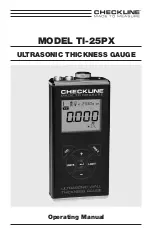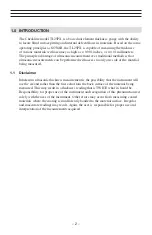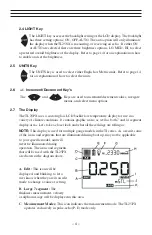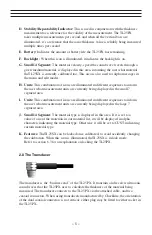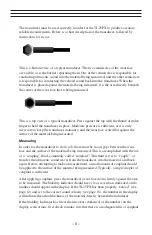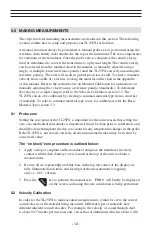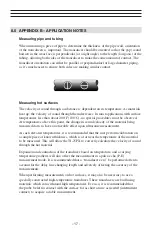
–12 –
5.0 MAKING MEASUREMENTS
The steps involved in making measurements are detailed in this section. The following
sections outline how to setup and prepare your TI-25PX for field use.
A manual zero must always be performed. A manual probe zero is performed using the
reference disk (battery disk) attached to the top of the instrument. The zero compensates
for variations of the transducer. Once the probe zero is completed, the sound velocity
must be determined to convert the transit time to a physical length. The sound velocity
can be selected from the material chart in the manual, or manually adjusted using a
single, or multiple, known reference point(s) until the TI-25PX correctly measuring the
reference point(s). The later will result in greater precision overall. To enter a common
velocity from a table of velocities, look up the material on the chart in the appendix
of this manual. Refer to the section below on Material Calibration for instructions on
manually adjusting the velocity using a reference point(s)/standard(s). To determine
the velocity of a single sample, refer to the Velocity Calibration section 5.2. The
TI-25PX can also be calibrated by selecting a common material type from a short list
of materials. To select a common material type to use for calibration, refer the Basic
Material Type section 5.3.
5.1 Probe zero
Setting the zero point of the TI-25PX is important for the same reason that setting the
zero on a mechanical micrometer is important. It must be done prior to calibration, and
should be done throughout the day to account for any temperature changes in the probe.
If the TI-25PX is not zeroed correctly, all the measurements taken may be in error by
some fixed value.
The “on block” zero procedure is outlined below:
1. Apply a drop of couplant on the transducer and place the transducer in steady
contact with the disk (battery cover) located at the top of the unit to obtain a
measurement.
2. Be sure all six repeatability/stability bars in the top left corner of the display are
fully illuminated and stable, and last digit of the measurement is toggling
only +/- .001” (.01mm
3. Press the
key to perform the manual zero. “PRB0” will briefly be displayed
on the screen, indicating the zero calculation is being performed.
5.2 Velocity Calibration
In order for the TI-25PX to make accurate measurements, it must be set to the correct
sound velocity of the material being measured. Different types of materials have
different inherent sound velocities. For example, the velocity of sound through steel
is about 0.233 inches per microsecond, versus that of aluminum, which is about 0.248
Содержание TI-25PX
Страница 1: ...MODEL TI 25PX ULTRASONIC THICKNESS GAUGE Operating Manual ...
Страница 21: ... 20 9 0 NOTES ...
Страница 22: ......

